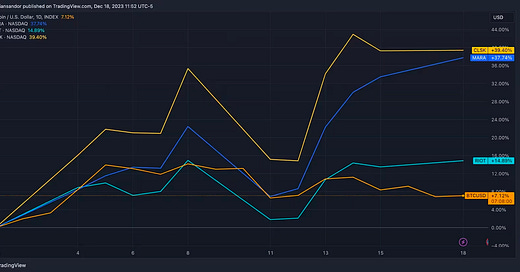Bitcoin Fees Spike During Ordinals Boom, Miners See Profit
New Ordinals trading has caused a spike in transaction fees and erratic movements for bitcoin’s price. Miners make heavy profits despite impending halving.
A recent flurry in Ordinals trading has had a variety of impacts on Bitcoin’s blockchain, but with the price yo-yoing and transaction fees skyrocketing, mining firms may see the highest benefit.
The start of the week saw a large dip for bitcoin starting late Sunday, but the price had recovered and then some a little more than 24 hours later. The dip was so sudden that around $166M in various short positions was lost during this period, with some of the biggest losers seeming to be the exchanges Binance and OKX, with $74M and $42M respectively. Although fluctuations in the price of bitcoin are an inherent feature in the space, things have still been going quite well for the asset as of late. A positive rally has lasted for months, hype remains high all around, seemingly large developments have proved a minimal effect. So, what could have caused this blip, and why was it only a blip? Quickly, the community took notice of spiking transaction fees on Bitcoin, and recognized that Ordinals were involved.
Ordinals are a controversial new protocol on Bitcoin’s blockchain, having only been introduced in early 2023. The protocol allows users to inscribe data onto the most minute quantities of bitcoin, allowing this data to be directly entangled with a global and decentralized blockchain that is constantly being verified. In industry terms, it creates the option for a Bitcoin NFT. This novel usage for the blockchain has inspired several projects to mint such assets, but it has also invited harsh criticism.
The Lightning Network, for example, uses shared channels to take pressure off Bitcoin’s blockchain, makingtransactions cheaper and easier. Ordinals, on the other hand, require validation directly on-chain, which eats up blockspace, and creates UTXOs that likely won’t be spent as currency. This “vulnerability” issue, as developer Luke Dashjr called it, would allow Ordinal minting and trading to spam the blockchain and cause quality-of-life issues for Bitcoiners everywhere.
In mid-December, it seems that this concern has begun to materialize. The first weeks of the month saw a new spike in Ordinal trading, as trading volume hit a new record of $36M. Binance announced on December 12 that it would begin listing BRC-20 SATS, a popular Ordinal project, and this caused no small degree of activity for the market. However, a closer analysis of the trading data revealed that some 85% of this new trading activity was caused by OKX, ironically one of the firms that saw its positions crunched hardest. Their Ordinals NFT in particular has been trading at high volumes, surpassing non-Ordinals competitors to become the best-performing NFT on the market on December 18. All this activity, however, caused bitcoin transaction fees to easily surpass their highest levels this year. This rapid and powerful clogging is a likely culprit for erratic price actions throughout the week.
So, OKX lost $42M from the downturn, but hit 24-hour trade volumes of over $50M. Seems like a fairly profitable move on their part, right? As it turns out, the real winners from this whole episode may actually be the Bitcoin miners themselves. Miners earn bitcoin by including new transactions into the next block, and the transaction fees paid by various users are rewarded to them. These fees are an additional reward beyond the actual new bitcoin that the miners generate, and with fees spiking, they provide a major source of income. So major, in fact, that miners are seeing wild profits in an environment that should be increasingly hostile.
The halving of Bitcoin is coming extremely close, and that should be pouring cold water on miners everywhere. Once block height hits 840,000, the rewards issued — currently 6.25 BTC per block — will be cut in half automatically to ensure the disinflation of Bitcoin’s supply issuance. Miners should be preparing for a situation in which many smaller firms will have to stop operations entirely, but instead, the sheer profitability of these transaction fees is more than enough to live on. In fact, rather than feeling the sting from these market conditions, some of the biggest miners reported double-digit rallies in their stock price since this clogging started.
This whole dynamic is a classic example of what Bitcoin advocate Andreas Antonopoulos called the “antifragility” of the Bitcoin network, as an article in Forbes described. Bitcoin’s disruptive and fluctuating tendencies are not an incidental component of decentralized currency, but they are rather a deeply-embedded part of Bitcoin’s nature. Bitcoin doesn’t seek to avoid minor stresses like this, but rather it welcomes them, for they help engender a sturdiness in the network and an innovative and diligent attitude from Bitcoiners. The problem of scalability is not yet solved, as it seems, but nevertheless this difficulty has itself created plenty of opportunities across the space. As long as there are chances to profit from issues like this, Bitcoin will have a strong base for bouncing back from anything.
In any event, bitcoin’s price is currently doing better than it was before these transaction fees underwent such a dramatic spike. It’s not just individual sectors of the space that have been making moves during this period, the space itself has been doing fine. This kerfuffle was initially caused by activities on the Bitcoin blockchain, and the opportunities are taking place there, too. Bitcoin is a resilient force of economic liberty worldwide, and this great stature was built by events just like this. Turning setbacks into profits, and fostering passionate ideas: sounds like Bitcoin to me.








Remarkable perspective 🎯 one man's loss is another man's gain.